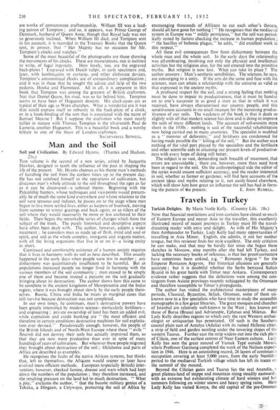A Tic-Toc World
Thomas Tompion : His Life and Work. By R. W. Symonds. (Batsford. £7 7s. Od.) THOSE lucky enough to own this book will find themselves in a tic-toc world reminding them, maybe, of the adagio from the " Clock " Symphony of Haydn. I was humming it to myself in a moment, having forgotten it for years. The tune makes its entrance, and returns in a major key ; and you have moved from one marvellous clock-case to its not less wonderful mechanism ; or are looking at the mezzotint of Tompion, after his portrait by Sir Godfrey Kneller, which shows him, alert and youthful, holding one of his watches in his hand. This is one of the surprises among so many beautiful photographs of clocks and watches, for one had thought of Tompion as some sort of a Dr. Coppelius. One had seen him, in imagination, as Bach may have looked in the years he composed The Art of Fugue. In hisportrait, but for his periwig, Tompion might well be a designer of jet aeroplanes. And this is much nearer to the truth. Not inaptly does Mr. R. W. Symonds compare the perfections of his clocks to that of Rolls-Royce engines. For it was the wonderful mechanism that was the work of Tompion. His lovely clock-cases and engraved back-plates are incidental to a golden age.
Nevertheless, Tompion had his Dr. Coppelius in the bent, crabbed form of Robert Hooke, the greatest experimental physicist of the century, another of the universal geniuses of the race of Wren, but the person of whom Pepys remarks, " Mr. Hooke, who is the most, and promises the least, of any man in the world that ever I saw." According to another account " he went stooping and very fast," which may well describe him. Hooke was for ever scurrying off to help Tompion with scientific advice. Another crony was Mr. Flamsteed, first Astronomer Royal, who makes an unexpected ap- pearance in Thornhill's ceiling of the Painted Hall at Greenwich. Flamsteed was crooked, Soo, and very irritable and ugly. They all quarrelled. Hooke, in his diary says, " Flamsteed is a conceited cockscomb." And they used to meet in coffee-houses. For even Hooke relaxed on occasion : " To Garaways. I was very brisk, smoked four pipes. Drank two chocolate. Discoursed with Tampion."
Tompion's home and workshop were at the corner of Water Lane and Fleet Street. Hence came all his clocks and watches ; he num- bered the watches carefully in three series, and they seem to have totalled between four and five thousand. Most fascinating to read, in an appendix to this book, are the newspaper advertisements for lost Tompion watches from The Daily Courant and The London Gazette. Nearly all the watches are in green or black shagreen cases, and the notices offer a reward and often end, " No questions asked." There are magnificent colour-plates of King William III 's repeating clock which goes for a year with one winding, in an ebony case veneered with silver ; and of another repeating clock, hardly less splendid, in a case of tortoiseshell with fine gilt mounts. These
are works of consummate craftsmanship. William HI was a lead- ing patron of Tompion ; and so, it appears, was Prince George of Denmark, husband of Queen Anne, though that Royal lady was not so generously inclined. When William Ill died, and Tompion sent in his account, it is recorded in the Treasury Books that the Queen sent, in answer, that " Her Majesty has no occasion for Mr. Tompion's clocks and watches."
Some of the most beautiful of the photographs are those showing the movements of his clocks. These are masterpieces, one is inclined to write, of fugal ingenuity. How lovely, too, are the engraved back-plates ! Engraved with Dutch tulips, in early specimens and, later, with lambrequins or curtains, and other elaborate devices. Tompion's astronomical clocks are of extraordinary complication ; and it was in these that he sought the advice and help of the two pedants, Hooke and Flamsteed. All in all, it is apparent in this- book that Tompion was among the greatest of British craftsmen. Not that Daniel Quare, his rival, was so far behind him. Tompion seems to have been of Huguenot descent. His clock-cases are as typical of their age as Wren churches. What a wonderful era it was that could express itself so robustly in the back-plate of a clock, or in a book-binding of the sort that is associated with the name of Samuel Mearne ! But I suppose the craftsman who most nearly tallies in stature with Thomas Tompion is the silversmith Paul de Lamerie, another Huguenot. This is a beautiful book and a worthy tribute to one of the finest of London craftsmen.
SACHEVERELL SITWELL.



























 Previous page
Previous page